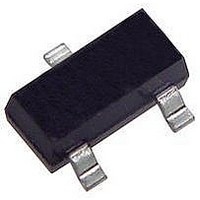HSMS-285B-TR1G Avago Technologies US Inc., HSMS-285B-TR1G Datasheet - Page 6

HSMS-285B-TR1G
Manufacturer Part Number
HSMS-285B-TR1G
Description
DIODE SCHOTTKY DETECT SS SOT-323
Manufacturer
Avago Technologies US Inc.
Datasheet
1.HSMS-285B-BLKG.pdf
(13 pages)
Specifications of HSMS-285B-TR1G
Diode Type
Schottky - Single
Voltage - Peak Reverse (max)
2V
Capacitance @ Vr, F
0.3pF @ 1V, 1MHz
Package / Case
SC-70-3, SOT-323-3
Diode Case Style
SOT-323
No. Of Pins
3
Peak Reflow Compatible (260 C)
Yes
Leaded Process Compatible
Yes
Forward Voltage
250mV
Repetitive Reverse Voltage Vrrm Max
2V
Pin Count
3
Forward Current If
1mA
Rohs Compliant
Yes
Lead Free Status / RoHS Status
Lead free / RoHS Compliant
Current - Max
-
Power Dissipation (max)
-
Resistance @ If, F
-
Lead Free Status / Rohs Status
Compliant
Available stocks
Company
Part Number
Manufacturer
Quantity
Price
Company:
Part Number:
HSMS-285B-TR1G
Manufacturer:
AVAGO
Quantity:
1 400
R
curve is measured for the diode under forward bias, and
the slope of the curve is taken at some relatively high
value of current (such as 5 mA). This slope is converted
into a resistance R
R
impedance of C
is approximately 1 MΩ. For a well designed zero bias
Schottky, R
out the junction capacitance. Moving up to a higher fre-
quency enables the measurement of the capacitance,
but it then shorts out the video resistance. The best mea-
surement technique is to mount the diode in series in a
50 Ω microstrip test circuit and measure its insertion loss
at low power levels (around -20 dBm) using an HP8753C
network analyzer. The resulting display will appear as
shown in Figure 7.
Figure 7. Measuring C
At frequencies below 10 MHz, the video resistance dom-
inates the loss and can easily be calculated from it. At
frequencies above 300 MHz, the junction capacitance
sets the loss, which plots out as a straight line when
frequency is plotted on a log scale. Again, calculation is
straightforward.
L
diode terminating a 50 Ω line on the input port. The re-
sulting tabulation of S
linear analysis program having the five element equiv-
alent circuit with R
then adjust the values of L
S
care must be taken to de-embed the parasitics of the
50 Ω test fixture.
6
I = I
P
11
S
V
and C
is perhaps the easiest to measure accurately. The V-I
and C
-10
-15
-20
-25
-30
-35
-40
=
matches the measured values. Note that extreme
S
R
(exp
S
3
= R
R ≈
V
0.026
P
I
J
50 Ω 9 KΩ
S
d
(
are best measured on the HP8753C, with the
10
26,000
+ I
–
V
are very difficult to measure. Consider the
0.026
V - IR
I
HSMS-285A/6A fig 10
S
is in the range of 5 to 25 KΩ, and it shorts
FREQUENCY (MHz)
b
+ I
0.026
at 25°C
J
J
I
b
= 0.16 pF when measured at 1 MHz — it
S
f
and R
d
50 Ω
)
.
V
100
, C
- 1)
V
50 Ω
.
J
11
0.16 pF
and R
can be put into a microwave
P
50 Ω
and C
1000
S
fixed. The optimizer can
3000
P
until the calculated
Detector Circuits
When DC bias is available, Schottky diode detec-
tor circuits can be used to create low cost RF and mi-
crowave receivers with a sensitivity of -55 dBm to
-57 dBm.
but in the most simple case they appear as shown in
Figure 8. This is the basic detector circuit used with the
HSMS-285x family of diodes.
In the design of such detector circuits, the starting point is
the equivalent circuit of the diode, as shown in Figure 6.
Of interest in the design of the video portion of the
circuit is the diode’s video impedance — the other
four elements of the equivalent circuit disappear at all
reasonable video frequencies. In general, the lower the
diode’s video impedance, the better the design.
RF
Figure 8. Basic Detector Circuits.
The situation is somewhat more complicated in the
design of the RF impedance matching network, which
includes the package inductance and capacitance
(which can be tuned out), the series resistance, the junc-
tion capacitance and the video resistance. Of these five
elements of the diode’s equivalent circuit, the four para-
sitics are constants and the video resistance is a function
of the current flowing through the diode.
where
Saturation current is a function of the diode’s design,
it is a constant at a given temperature. For the HSMS-285x
series, it is typically 3 to 5 µA at 25°C.
Saturation current sets the detection sensitivity, video re-
sistance and input RF impedance of the zero bias Schottky
detector diode. Since no external bias is used with the
HSMS-285x series, a single transfer curve at any given fre-
quency is obtained, as shown in Figure 2.
[1]
RF
IN
I = I
IN
R
Avago Application Note 923, Schottky Barrier Diode Video Detectors.
I
I
j
S
b
=
=
S
R
= diode saturation current in µA
= bias current in µA
(exp
S
NETWORK
NETWORK
= R
Z-MATCH
8.33 X 10
R ≈
Z-MATCH
V
0.026
[1]
I
S
d
(
I
S
26,000
+ I
–
These circuits can take a variety of forms,
0.026
V - IR
I
+ I
S
b
0.026
+ I
b
at 25°C
-5
I
b
f
S
n T
)
- 1)
= R
VIDEO
OUT
V
– R
VIDEO
OUT
s
[2]
and























